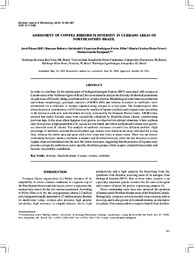Assessment of cowpea Rhizobium diversity in cerrado areas of Northeastern Brazil.
Assessment of cowpea Rhizobium diversity in cerrado areas of Northeastern Brazil.
Autoria: ZILLI, J. E.; VALISHESKI, R. R.; FREIRE FILHO, F. R.; NEVES, M. C. P.; RUMJANEK, N. G.
Resumo: In order to the optimization of biological nitrogen fixation (BNF) associated with cowpea in Cerrado areas in the Northeast region of Brazil , this work aimed to analyze the diversity of rhizobial populations in eight areas of Cerrado, during a soybeam and rice-cowpea rotation . morphological traits (mucous productions and colony morphology), genotypic analyzes (ARDRA 16S) and intrinsic resistance to antibiotics were determined for a collection of isolates captured using cowpea as host-plant. The morphological data showed a inverse correlation (p> 0.05) bettween the number of legume (soybean and cowpea) crops, according to the history of each area, and rhizobium diversity, estimated by the Shannon-Weaver index. ARDRA data showed that native Cerrado areas were exclusively colonized by Bradyrhizobium elkanii, corroborating previous data. In the areas where legumes were grown, we observed two distinct situations: where soybean only were grown, a high proportion of B. japonicum was fond, and where soybean and cowpea were grown, we observed more B. elkanii. The analysis of antibiotic resistance revealed five different profiles. High percentage of antibioc resistant Bradyrhizobium spp. isolates were found in the areas cultivated for a long time, whereas the natives area and areas with a few crops had fewer resistant strain. There was an inverse relationship between intrinsic antibiotic resistance and rhizobial diversity, while the last decreases as more legume crops are introduced into the area, the former increases, uggesting that the presece of legumes may provide ecological conditions to select specific rhizobium gropus, which acquire competitiveness traits and become successfully established.
Ano de publicação: 2004
Tipo de publicação: Artigo de periódico
Unidade: Embrapa Meio-Norte
Observações
1 - Por padrão são exibidas publicações dos últimos 20 anos. Para encontrar publicações mais antigas, configure o filtro ano de publicação, colocando o ano a partir do qual você deseja encontrar publicações. O filtro está na coluna da esquerda na busca acima.
2 - Para ler algumas publicações da Embrapa (apenas as que estão em formato ePub), é necessário ter, no celular ou computador, um desses softwares gratuitos. Sistemas Android: Google Play Livros; IOS: iBooks; Windows e Linux: software Calibre.
Acesse outras publicações
Acesse a Base de Dados da Pesquisa Agropecuária (BDPA) para consultar o acervo completo das bibliotecas da Embrapa.

